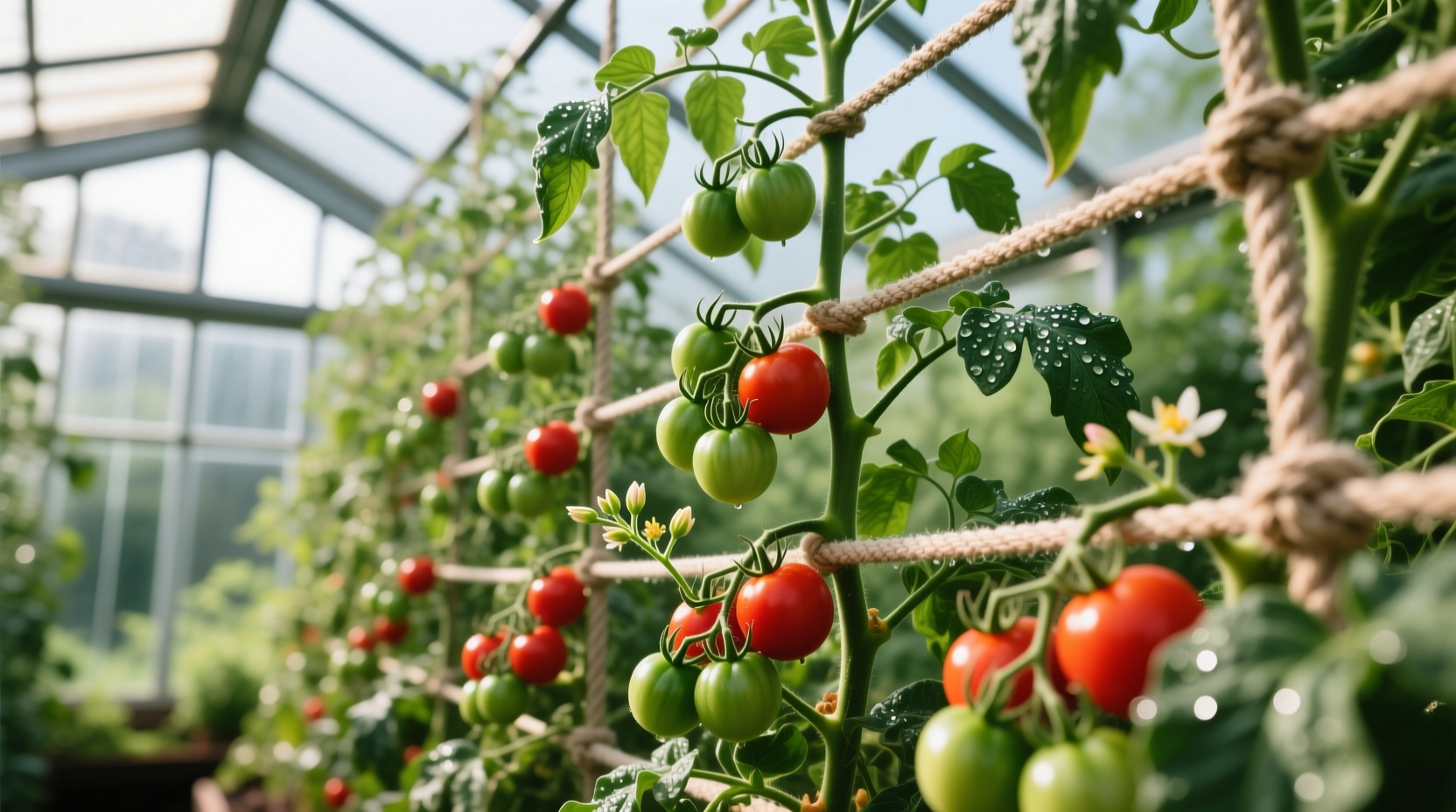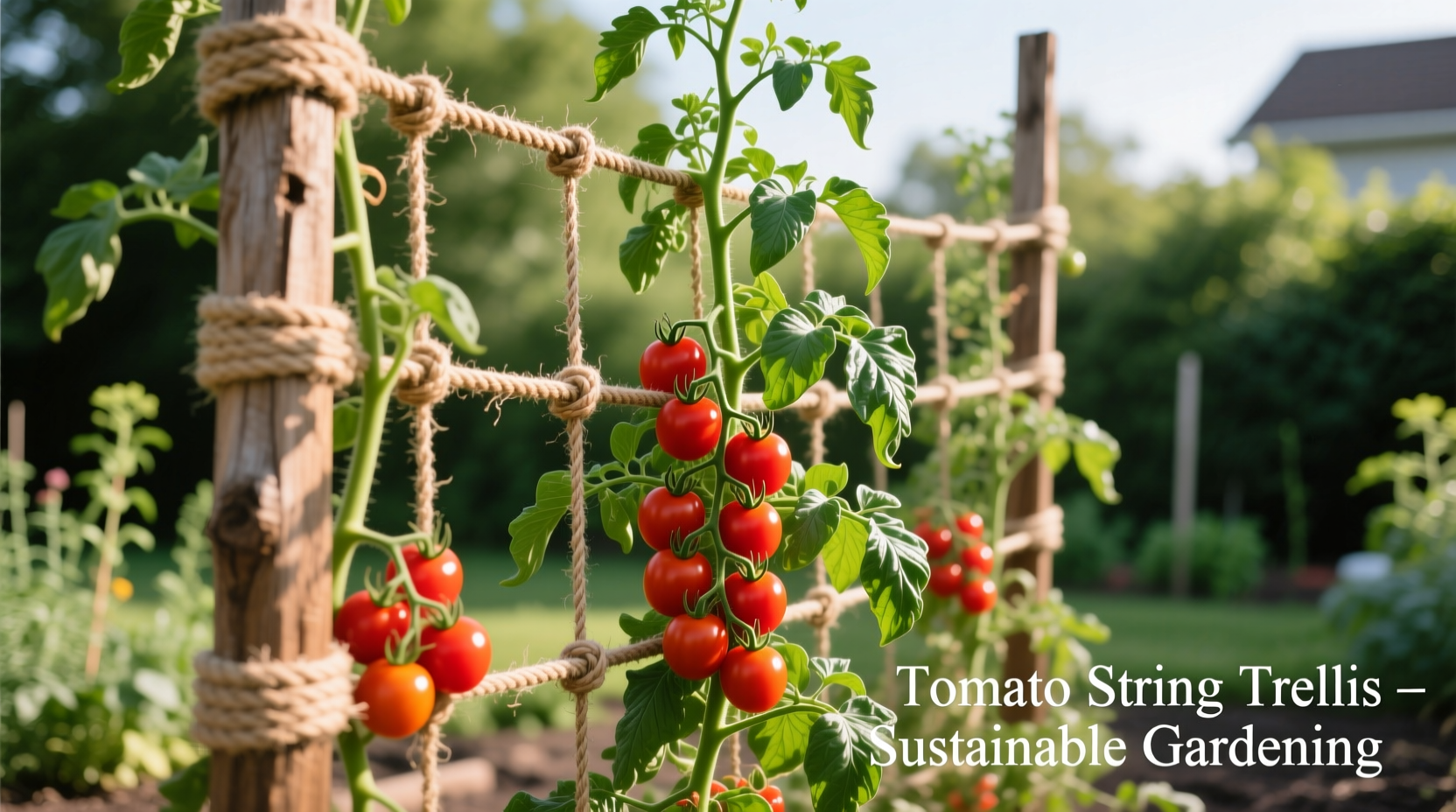Tomato string trellis systems increase yield by 20-30% while reducing disease incidence by supporting plants vertically. This complete guide shows exactly how to install an effective string trellis system for tomatoes using affordable materials, with step-by-step instructions validated by university agricultural research.
Discover why commercial tomato growers consistently choose string trellising over cages or stakes for superior results. Unlike traditional methods that restrict growth, a properly installed string trellis system guides plants upward while distributing weight evenly, preventing stem damage and improving air circulation. Research from Cornell University's College of Agriculture and Life Sciences confirms that trellised tomatoes produce larger, cleaner fruit with fewer fungal issues compared to ground-growing methods.
Whether you're growing determinate or indeterminate varieties in a backyard garden or small farm, this guide provides everything you need to implement a professional-grade string trellis system. We'll cover material selection, installation timing, step-by-step setup, seasonal maintenance, and troubleshooting common problems—based on decades of horticultural research and practical field experience.
Why String Trellising Outperforms Traditional Tomato Support Methods
String trellising has become the industry standard for commercial tomato production for compelling reasons. Unlike rigid cages that limit growth or stakes that require constant re-tying, string systems provide dynamic support that grows with your plants. The vertical orientation maximizes sunlight exposure to all parts of the plant while keeping fruit off the ground—critical for preventing soil-borne diseases like early blight and anthracnose.
According to the University of California's Agriculture and Natural Resources department, properly trellised tomatoes show 25% higher yields on average compared to unsupported plants. The improved air circulation around trellised plants reduces humidity at the foliage level, creating an environment less hospitable to common tomato pathogens.
| Support Method | Yield Improvement | Disease Reduction | Labor Requirements | Cost per Plant |
|---|---|---|---|---|
| String Trellis | 20-30% | 40-50% | Moderate (initial setup) | $0.25-$0.50 |
| Wire Cages | 10-15% | 20-30% | Low | $1.50-$3.00 |
| Wooden Stakes | 5-10% | 15-25% | High (weekly) | $0.75-$1.25 |
| Ground Growing | Baseline | 0% | Very Low | $0 |
Comparison of tomato support methods based on multi-year studies from Cornell University and UC Davis Agricultural Extension
Essential Materials for Your Tomato String Trellis System
Building an effective string trellis requires specific materials designed for agricultural use. Don't waste time with hardware store twine that will degrade in sunlight—professional growers use specialized horticultural twine that maintains strength throughout the growing season.
Required materials:
- 1,200-1,500 lb test strength horticultural twine (polypropylene)
- 8-10 foot T-posts or sturdy wooden posts (one per 10-15 feet)
- Heavy-duty line tightener or tensioner
- Twist ties or plant clips (avoid damaging string)
- Anchor posts for end supports (18 inches deep)
- Top support wire or cable (12-gauge)
The University of Florida's Institute of Food and Agricultural Sciences recommends using UV-resistant twine specifically designed for agricultural applications. Standard cotton or nylon string loses up to 60% of its strength within 30 days of sun exposure, while professional horticultural twine maintains integrity for the entire growing season.

Step-by-Step Installation: Building Your String Trellis System
Timing your installation correctly is crucial—set up your trellis system when plants reach 12-18 inches tall, before they begin flowering. Installing too early can damage young plants, while waiting too long makes training more difficult.
Phase 1: Foundation Setup (Before Planting)
- Install anchor posts at both ends of your row, burying 18 inches deep
- Place intermediate posts every 10-15 feet along the row
- Run a top support wire between posts at 6-7 feet height
- Secure with line tighteners to maintain proper tension
Phase 2: String Application (When Plants Reach 12-18 Inches)
- Cut twine to length (allow 2-3 feet extra for tying)
- Attach one end to the base of the plant using a loose figure-eight
- Run string vertically to the top wire, maintaining slight tension
- Secure to top wire with a secure but adjustable knot
- Repeat for each plant, spacing strings 12-18 inches apart
As your plants grow, you'll need to periodically "twine" them by gently wrapping the main stem around the string in a clockwise direction. This training technique, documented in Oregon State University's vegetable production guide, encourages natural upward growth while providing continuous support.
Seasonal Maintenance: Keeping Your String Trellis Effective
Your string trellis system requires regular attention throughout the growing season to maintain effectiveness. Create a simple maintenance schedule:
- Weekly: Check string tension and adjust as needed
- Bi-weekly: Train new growth by wrapping stems around string
- Monthly: Inspect for wear points where string contacts stems
- After heavy rain: Verify post stability and re-tighten if necessary
One critical maintenance tip often overlooked: replace any string showing signs of fraying immediately. Damaged twine creates weak points that can fail under plant weight. The University of Massachusetts Vegetable Extension notes that 70% of trellis failures occur at worn string points rather than at attachment points.
Context Boundaries: When String Trellising Works Best
While string trellising offers significant advantages, it's not universally appropriate. Understanding these context boundaries will help you determine if this system suits your specific growing conditions:
- Ideal for: Indeterminate tomato varieties, commercial production, humid climates, small-space gardening
- Less effective for: Determinate varieties (bush types), extremely windy locations, very short growing seasons
- Requires adjustment for: Organic systems (use biodegradable twine), container gardening (miniature trellis adaptation), cold climates (delay installation until after last frost)
According to research published in the American Journal of Plant Sciences, string trellising shows the greatest benefits in regions with high humidity where disease pressure is significant. In arid climates with excellent air circulation, the yield advantage decreases to 10-15% compared to 25-30% in humid regions.
Troubleshooting Common String Trellis Problems
Even well-designed systems encounter issues. Here's how to address the most frequent problems:
Problem: String cutting into plant stems
Solution: Use wider twine (3/16" instead of 1/8") or add protective sleeves at contact points. Never tie string directly against stems—maintain slight slack to allow for growth.
Problem: Plants outgrowing the trellis height
Solution: Implement a "topping" strategy when plants reach 80% of trellis height. Pinch off the growing tip to redirect energy to fruit production rather than vertical growth.
Problem: String losing tension during hot weather
Solution: Install line tighteners at both ends of the system. Check and adjust tension early in the morning when temperatures are cooler.
Seasonal Evolution: How Your String Trellis System Changes Through the Growing Season
Understanding the seasonal evolution of your string trellis system helps anticipate needs at each growth stage:
- Early Season (Transplant to First Flower): Focus on proper string attachment and initial training. Plants should grow vertically with minimal side branching.
- Mid-Season (Fruiting Begins): Increase monitoring frequency as plant weight increases. Begin pruning side shoots to maintain single-stem growth.
- Late Season (Peak Production): Check for wear points daily. Consider adding secondary support strings for heavily laden branches.
- End of Season: Gradually reduce water to encourage ripening. Remove strings carefully to avoid damaging plants during harvest.
This progression follows the natural growth pattern of indeterminate tomatoes, as documented in the USDA's Sustainable Agriculture Research and Education program guidelines. Adapting your maintenance schedule to these phases prevents common problems before they occur.
Maximizing Your Harvest with Proper String Trellis Management
The ultimate goal of any tomato support system is maximizing quality harvest. With proper string trellis management, you'll notice several harvest advantages:
- Fruit develops more uniform color due to consistent sun exposure
- Easier harvesting with less back strain (no bending to ground level)
- Cleaner fruit with fewer soil splashes and blemishes
- Extended harvest window as plants remain productive longer
- Simplified pest monitoring with better visibility of entire plant
For best results, harvest tomatoes in the early morning when sugars are highest and fruit is firmest. The vertical orientation of trellised plants makes identifying ripe fruit significantly easier than with ground-growing methods.











 浙公网安备
33010002000092号
浙公网安备
33010002000092号 浙B2-20120091-4
浙B2-20120091-4